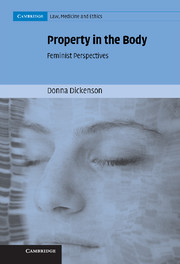Book contents
- Frontmatter
- Contents
- Acknowledgements
- Preface
- 1 Do We All Have ‘Feminised’ Bodies Now?
- 2 Property, Objectification and Commodification
- 3 The Lady Vanishes: What's Missing from the Stem Cell Debate
- 4 Umbilical Cord Blood Banks: Seizing Surplus Value
- 5 The Gender Politics of Genetic Patenting
- 6 Biobanks: Consent, Commercialisation and Charitable Trusts
- 7 The New French Resistance: Commodification Rejected?
- 8 Tonga, the Genetic Commons and No Man's Land
- 9 Afterword
- Bibliography
- Index
3 - The Lady Vanishes: What's Missing from the Stem Cell Debate
Published online by Cambridge University Press: 15 December 2009
- Frontmatter
- Contents
- Acknowledgements
- Preface
- 1 Do We All Have ‘Feminised’ Bodies Now?
- 2 Property, Objectification and Commodification
- 3 The Lady Vanishes: What's Missing from the Stem Cell Debate
- 4 Umbilical Cord Blood Banks: Seizing Surplus Value
- 5 The Gender Politics of Genetic Patenting
- 6 Biobanks: Consent, Commercialisation and Charitable Trusts
- 7 The New French Resistance: Commodification Rejected?
- 8 Tonga, the Genetic Commons and No Man's Land
- 9 Afterword
- Bibliography
- Index
Summary
In most public discussion of the ethical issues in stem cell research, only the status of the embryo seems to count. Yet because ova are crucial to stem cell research, particularly in somatic cell nuclear transfer, there are also important regulatory issues concerning protection of women from whom ova are taken. Rarely are these issues aired: hence the title of this chapter, ‘The lady vanishes’. In most commentaries and debates, the women from whom the ova are taken have virtually disappeared from view.
In the extraction of ova for IVF therapy, a more commodified system already prevails than in any other form of tissue donation, even in the highly commercialised tissue economy of the USA. Many recent reports have documented a burgeoning trade in human ova for IVF, with eggs being extracted from Eastern European women and sold on to infertile couples in Britain, Germany, Israel and other wealthier countries. Young Ukrainian women, for example, may be flown to clinics in Cyprus, or even as far as Belize, to have their eggs extracted. The price paid to these women is typically between US$200 and US$300 per cycle, whereas clients are charged between £7,900 and £11,000, allowing the private clinics to make a healthy profit even if they have to pay for the odd air fare or two. That commercialised and globalised network of clinics is ready and available for ‘producing’ ova to be used in stem cell research rather than in IVF therapy.
- Type
- Chapter
- Information
- Property in the BodyFeminist Perspectives, pp. 58 - 82Publisher: Cambridge University PressPrint publication year: 2007

